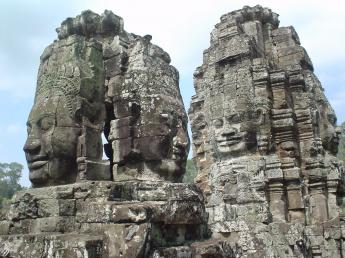Bayon
|
|
The Bayon is a temple at Angkor, Cambodia. It was built in the 13th century as the state temple of king Jayavarman VII, and stands at the centre of his capital, Angkor Thom. Its most distinctive feature is the multitude of smiling faces on the towers which rise up to its central peak. It also possesses two sets of bas-reliefs, which depict an unusual combination of mythological, historical and mundane events. The main current conservatory body, the JSA, has described the temple as "the most striking expression of the 'baroque' style", compared to the classical style of Angkor Wat.
History
The Bayon was the last state temple to be built at Angkor, and the only one to be built primarily as a Mahayana Buddhist temple (although various local deities were also worshipped there). It was the centrepiece of Jayavarman VII's building program, and the similarity of the faces on the temple's towers to other statues of the king have led many scholars to the conclusion that the faces are, at least in part, representations of Jayavarman VII (although Avalokitesvara is another possibility). Under the reign of Jayavarman VIII in the mid-13th century the temple was converted to Hinduism. In later centuries Theravada Buddhism became dominant, before the temple was eventually abandoned to the jungle. Current features which were not part of the original plan include the terrace to the east of the temple, the libraries, the square corners of the inner gallery, and the upper terrace.
In the first part of the 20th century conservation work was led by the Ecole Française d'Extrême-Orient, which restored the temple using the anastylosis technique. Since 1995 the Japanese Government team for the Safeguarding of Angkor (the JSA) has been the main conservatory body, holding annual symposia.
The site
The temple is orientated towards the east, and so its buildings are set back to the west inside enclosures elongated along the east-west axis. Because the temple sits at the exact centre of Angkor Thom, roads lead to it directly from the gates at each of the city's cardinal points. The temple itself has no wall or moats, these being replaced by those of the city itself: the city-temple arrangement, with an area of 9 square kilometres, is much larger than that of Angkor Wat to the south (2 km²).
Bayon04.png
Bayonnavalbat01.JPG
Bayonmarket01.JPG
The outer gallery encloses a courtyard in which there are two libraries (one on either side of the east entrance). 16 chapels formerly in this courtyard were demolished by Jayavarman VIII. The inner gallery is raised above ground level and has doubled corners, with the original redented cross-shape later filled out to a square. Its bas-reliefs, later additions of Jayavarman VIII, are in stark contrast to those of the outer: rather than set-piece battles and processions, the smaller canvases offered by the inner gallery are decorated for the most part with scenes from Hindu mythology. There is however no certainty as to what some of the panels depict, or as to their relationship with one another. One gallery just north of the eastern gopura, for example, shows two linked scenes which have been explained as the freeing of a goddess from inside a mountain (Glaize), or as an act of iconoclasm by Cham invaders (Freeman and Jacques). A nearby series of panels show a king fighting with a serpent and dying, and have been connected with the legend of the leper king. Less obscure are depictions of the construction of a Vishnuite temple (south of the western gopura) and the Churning of the Sea of Milk (north of the western gopura).
Bayoncramped01.JPG
Like the inner gallery, the central massif was originally cruciform but was later filled out, this time making it circular. It rises 43 metres above the ground. The original Buddha image from the central shrine was removed and smashed by Jayavarman VIII, but has now been restored and is displayed in a pavilion to the northeast of the temple.
References
- Freeman, Michael and Jacques, Claude. Ancient Angkor. River Books, 1999. ISBN 0834804263.
- Glaize, Maurice. The Monuments of the Angkor Group. Revised 1993 and published online [1] (http://www.theangkorguide.com/cgi-bin/MasterFrameReunion.cgi?http%3A//www.theangkorguide.com/text/part-two/angkorthom/bayon.htm).
- JSA Bayon Master Plan (http://angkor-jsa.org/bayon/index_e.html) Accessed 17 May 2005.
- JSA Bayon Symposia (http://www.unesco.org/culture/Bayon/interface/en/symposiums.html) Accessed 17 May 2005.de:Bayon

